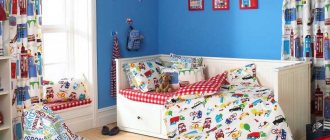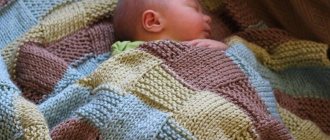Every hour of a newborn's sleep is a gift to the mother. It is impossible to force a baby to sleep, but you can buy a “magic” blanket for a baby’s crib - warming, breathable, hygroscopic, anti-allergenic, and create ideal conditions for long sleep. It is a kind of replacement for a mother’s hug, so there is no need to skimp on quality.
How to choose the right one
The main selection criterion is the season. For the cold season, a newborn will need a warm blanket. It is used mainly in a crib. You can also wrap your child up and take him outside, onto a balcony, into a loggia while he sleeps. This is better and faster than putting on and buttoning up the overalls. For warm spring and summer, it is better to choose light and thin models. Usually buy two blankets for the crib for each season, plus an additional small product for the stroller. It will cover the newborn from the wind.
Other selection criteria:
- safety of materials. If parents suffer from allergies, there is a high probability of a reaction in the newborn. Therefore, it is better to purchase hypoallergenic items;
- softness, lightness. It will be uncomfortable for a newborn to sleep under a heavy, scratchy or rough blanket;
- ease of care. It is better to give preference to machine washable products;
- breathability. The product must not create a greenhouse effect.
A common question is which blanket is best for a newborn based on its shape. In addition to square and rectangular models, you can now find interesting options with rounded corners, hoods, and ties. There are various decorations - ruffles, bows, appliqués, embroideries, tassels. All this is cute, but for use in a crib, classic blankets without decoration are best suited. It's easy to match them with a duvet cover. We remember that the newborn will soon grow up, he will pull ribbons and other elements into his mouth, and may tear them off.
Is the baby warm?
First of all, the blanket should provide good protection from the cold. Models with cotton filling are often not recommended for children. Such a product cannot be washed; it is difficult to find a dry cleaner that will undertake to put it in order. You can immediately reject this filler, and then bitterly regret your decision.
We recommend: Pros and cons of camel hair pillows
In many cities in winter, problems with heating often arise: either the steam supplied to the radiators is too cold, or the pumping station will fail in severe frosts. It's cold for both adults and children. This is where a cotton blanket will help you out. It may be heavy and difficult to care for, but this model will save your baby from the cold. Buy your baby such bedding, and no mistakes of the management company will make him freeze.
If your apartment is constantly cold, buy a wool blanket. It is hygroscopic and absorbs sweat well, but when purchasing, you need to touch the product and determine its cruelty. The wool must be well processed so that it is not itchy and does not contain splinters, thorns and other foreign inclusions. If you are not buying a woven blanket, but a cover with stitched wool filling, pay attention to the label. The density of the stuffing determines how warm the baby will be under such a blanket. For apartments with poor heating system performance in winter, you need to stay at 420 g/m2.
Advice
When choosing a wool blanket, focus only on softness and warmth. All information about radiation protection, the healing effect and the effects of lanolin from the hair of various animals on the skin is a common advertising gimmick.
Wool is considered a light filler, but if you want your baby to be warm and not feel the weight of the blanket at all, choose a model made of holofiber or padding polyester. These materials can be washed and do not harbor harmful insects. If you are going on a trip, the product can be compactly packed, it will not take up much space, and its weight is almost imperceptible. Such things can be safely packed and sent to the mezzanine for the summer; moths won’t eat them.
In summer
Some parents doubt whether a newborn needs a blanket at all during the warm season. You can cover the baby with a diaper, a sheet, or use a thin blanket. There is some truth in this. It’s just not always warm at night, plus air conditioners and fans are used in the rooms. The second point is that in spring and autumn it is hot to sleep under winter blankets, but cold under a diaper. Therefore, summer products are actively used in the demi-season.
In the warm season, it is advisable to use a blanket made of flannel or fleece for the baby.
Baykovoe
If you still don’t know which blanket is best to choose for the summer, feel free to give preference to the good old yarn.
What are the advantages of the material:
- natural and hypoallergenic material;
- absorbs moisture;
- allows air to pass through;
- tolerates repeated washings well;
- does not wear out for decades.
A significant drawback of flannelette blankets is their primitive design. Most often, manufacturers produce products in checkered, striped, and diamond patterns in dull and faded shades. The beds with them resemble hospital rooms. It’s better to immediately buy a nice duvet cover.
Calico
Our grandmothers' favorite material. It has still not lost its relevance. Blankets for newborns made from calico are suitable for the warm season, used in cribs, strollers, as bedding on the floor, and upholstered furniture.
What are the advantages of calico:
- hypoallergenic and safe;
- durability;
- ease of care;
- does not wrinkle;
- light weight;
- absorbs moisture well.
There is only one drawback - it is difficult to find on sale. Calico usually acts as a cover, with other fillers inside.
Fleece
Manufacturers actively use fleece for sewing clothes and bedding for children's cribs. But this particular material is not suitable for newborns, despite its hypoallergenicity.
Significant disadvantages of fleece blankets:
- do not allow air to pass through well;
- do not absorb moisture;
- collect dust, lint sticks;
- quickly lose their appearance.
What are the advantages? Only cheapness and variety of colors. Bright and cute designs attract parents. Blankets are used in cribs, strollers, they cover changing tables, and wrap newborns sleeping on the street.
which blanket is best for a newborn's crib?
I tried a method that was new to me, but I adjusted it to suit myself. I would like to note that I trained a 1.5-month-old child who was on breastfeeding and canceled only night feedings. Before this, the child slept in his crib for 3 hours, and then nibbled at me for the rest of the night, I “slept” like “zyu”, did not get enough sleep, breastfeeding ceased to be a joy... In a word, I was ready to move the child not only to a separate crib, but and to another room...
The essence of the method:
Many parents consider it normal to get up 2-3, or even 4-5 times at night to see their one-and-a-half-year-old child to give him a bottle. But this is NOT the NORM, just like the case when an 8-month-old baby does not sleep until midnight without any signs of fatigue, or when a one-year-old baby begins to scream loudly as soon as his mother, having put him in the crib, wants to leave the room. From 6-7 months of age, all children should be able to: - go to bed without crying and with joy - fall asleep on their own without outside help alone in the room - sleep for 10-12 hours without a break - sleep in their own crib (and not in their parents’ bed), in the dark without a night light on. This description applies to all healthy children if they do not have colic (which usually goes away by 4-5 months), milk intolerance, acute respiratory infections, bronchitis, etc. If your baby is already 6 months old and not sick, but has not yet learned to sleep through the night, he may have problems with childhood insomnia in the future. Childhood insomnia is explained: - in 98% of cases by incorrect sleep habits - in 2% by psychological problems (see end of chapter) Childhood insomnia caused by incorrect habits has the following characteristics: - the child cannot fall asleep on his own without outside help - wakes up at night (from 3 to 15 times) and cannot fall back to sleep on his own and requires help from parents (rocking, bottle, etc.) - shallow sleep - the slightest noise can wake him up - sleeps fewer hours than indicated in the table for his age In such cases parents resort to auxiliary methods: rocking the baby, patting the head, giving him something to eat, drink, etc. The baby eventually falls asleep, but the problem is that when he wakes up again, he has to start all over again. If you decide to change this situation, you must follow the following rule: you must strictly follow our instructions, follow them literally, the slightest deviation or change can lead to failure! What does it take to develop good sleep habits? Let's repeat the general rules: - parents should be calm and confident in what they are doing, and also always follow the same pattern of behavior when putting the baby to bed, create a ritual. - the child should associate sleep with external elements that can stay with him all night: a crib, a teddy bear, a pacifier, a favorite blanket, etc. So, let's forget the past and imagine that our baby was born today. Let's start by selecting the external elements. We remember that they should stay with the baby all night (that is, they should not be dangerous, too small for him to swallow, hard so that he does not hit himself in his sleep, etc.) and that they should not require our presence ( for example, a bottle of tea is not suitable, since someone has to fill it at night). With a child 2-5 years old, you can prepare a drawing to hang above the crib. After dinner, dad (mom) says to the baby: “Let’s go to the room, let’s draw a beautiful picture.” The kid can draw a sun or a cloud over the house himself, and dad can add a bird or tree, etc. Mom can prepare a carousel to hang over the crib (just cut out a doll or an airplane from paper, make a ball out of shiny paper and hang it over the crib using a rope or elastic band). You don't have to create masterpieces, you can just buy something suitable. The main thing is that the child has something fundamentally new, something that was not there before and that he likes. If you used to put him to bed differently every night, now you need to create a ritual. Decide for yourself what is more convenient for you: swimming, dinner, playing for half an hour and going to bed. What you decide now, you will have to do the same every evening. Let us give you some advice. In accordance with natural biological rhythms, it is best to let your child eat on the following schedule: breakfast around 8 o'clock, lunch around 12, afternoon snack around 16 and dinner around 20. Try not to deviate too much from this schedule, as these are the biological rhythms of children. In any case, if for some reason you cannot adhere to this entire schedule, remember: the child falls asleep easiest in the winter at 20.00-20.30, and in the summer at 20.30-21.00. This is due to the peculiarities of the brain functioning of children. First day of re-education. So, you have everything ready, your schedule and evening ritual have been chosen. After dinner, dad (mother, grandmother) play calm games with the baby for 10-15 minutes, then together they hang a picture over the crib. They explain that this is a poster and that he will sleep with the baby all night. If your baby still sleeps with a pacifier, buy him several and place them around the crib so that your baby can easily find at least one in the dark. If you don’t think about this moment, the baby will wake you up at night so that you help him find the pacifier and then - goodbye, re-education! Second step: mom or dad choose a toy from those the baby already has and give him a name. After this they say to the baby: This is your friend Mishka (Petya, etc.). He will sleep with you all night. Don’t let your baby choose: remember, we know how to sleep and we teach him, not he us, now you decide. Even if your child is 4 years old, in this situation we must treat him like a newborn who does not yet know or know how to do anything. If you have to deprive your baby of something that he used to have (a bottle, etc.), explain to him that his new night friends replace the old ones and that they will remain with him all night and in the morning when he wakes up there will be more with him. Remember - the baby’s requests and demands at the time of going to bed can affect the correct sleep habit - the child should not tell his parents how he should sleep and what he needs for this, in this situation, parents are teachers, and children learn to sleep, and not the other way around . The calm, confident tone of parents should show this to their children. So, the time has come to put your baby in the crib. Act as if you do this every day. Calmly change the baby's clothes, put him in the crib and cover him. Don’t expect the baby to close its eyes, turn on its side and snore. Firstly, the baby has not yet been “re-educated”, and secondly, he has already realized that you have prepared some kind of surprise for him. Most likely, he will immediately jump to his feet and start screaming wildly as soon as he realizes that mom wants to leave the room. Don't try to put him down again right away. Sit next to the crib or take him on your lap and tell him: “Kitty, mommy and daddy want to teach you how to sleep. Look, you are not alone: your teddy bear, drawing, etc. are with you. They will all sleep with you all night.” This speech will take between 0.5 and 2 minutes. Depends on what you include in the list (curtains, bike next to the crib, etc.). The main thing is not to get annoyed and speak calmly. It doesn't matter at all whether the child understands well what you say to him. Most likely, during your entire speech, the child will scream like crazy in the hope that he will be able to return to the old days. Ignore the crying, keep talking. These are the moments that require willpower and courage from you. Your baby will be ready to do anything so as not to lose his “privileges.” Let us give just a short list of what children in our practice were capable of in order to pity their parents and return “their happy past”: children cried, made sad faces, asked to drink, write and eat, threw tantrums with hiccups, made themselves vomit, pooped etc. Despite all this performance that your baby will give you, you must remain calm and remember: you are teaching him to sleep, not he is teaching you. You are doing this for his future, for his health and for your nervous system. After your short speech above, put your baby back in bed. Attention: after this point it should not be touched until the next morning. If he gets up again, ignore him. Say, “Good night, fish (pussy, etc.),” turn off the lights, and leave the room. Leave the door almost completely closed (a small crack so you can hear what is happening). Attention: it makes no difference whether the baby is 6 months or 5 years old. The only difference is how he can fight you. A six-month-old baby can only cry, but a 4-5-year-old can talk, scream, beg, get out of the crib, etc. In this case, we recommend organizing some kind of barrier to exit the room. Do not lock the door with a key, etc. This could terrorize your child! Don't be afraid if he falls asleep on the floor, etc. Firstly, children rarely do this, because they love convenience, and secondly, even in this case, the goal is achieved - the baby fell asleep on his own. Then you just need to put him in the crib. Up to this point we have considered the point of view of adults. But how does the baby feel in such a situation? Children communicate with adults according to a certain pattern: action-reaction. Children do certain things because they expect certain reactions. Consider the situation: a six-month-old baby. They put him in his crib, he begins to sing “a-a-a-a” and clap his hands. What will mom and dad say? “What a bunny!” And they will mind their own business. But the same baby begins to scream like crazy, turns brown-red or purple, and hiccups. What do parents do? They run: “Bunny, are you feeling bad? What happened to you? Does your tummy hurt? Teeth cutting? Kitty, now mom (dad) will rock you (carry you in her arms, etc.).” What does a baby like more: lying alone in a crib or being the center of attention of all relatives? What will the baby do next time he wants his parents' attention? What will a 4-5 year old child do? He has enough imagination to make his parents retreat first! Let's return to the process of putting to bed. What will our 4-year-old do as soon as we give him his teddy bear? Maybe he'll throw him on the floor. If you pick it up and give it to him again, what will he do? He throws the bear on the floor again. If we continue like this, who will win? Baby!!! Because he took a certain action and achieved the desired reaction. You fell for his bait! If your baby threw a teddy bear, a pacifier, a blanket, a pillow on the floor, and you continue to talk calmly, then collect everything, put it in his bed, turn around and leave the room despite his wild screams, who will win? Another example: you put your baby in the crib, and he immediately rises to his feet. You put it down again, it comes up again. You don't want to put him to bed all night, but he wants to continue this game as long as possible, because this way he has your full attention. So put him in the crib and leave the baby alone. If he wants to climb, let him climb as much as he wants. What else can your baby do to get your attention? “I’m thirsty”, “ah-ah-ah”, “bo-bo”, etc. The child may even make himself vomit. Don't be alarmed, nothing happens to him. Wash him, change the sheets and put him back in the crib. You may be nervous (but don’t show it outwardly). Remain outwardly calm and determined: your child must learn to sleep. The baby may also scream and cry like crazy (then tell the neighbors that his ears hurt, poor thing). In such a situation, the baby may cry so loudly that the windows of the neighbors across the street may rattle. But you must have courage and hold on: your “war” has just begun, and fortunately it will only last a few days. However, we cannot leave the baby to cry for long. Why? Because “re-educate” does not mean punish. Parents are usually advised to let their baby cry until he falls asleep from fatigue. Never do this! When you leave the room for the first time, look at the clock: until the baby falls asleep, you will have to return to his room from time to time. REMEMBER: you are not coming back to calm him down, and not to make him stop crying, and not to put him to sleep. But only to show him that you have not abandoned him. How often should you return to your baby? Consider the sign below, it all depends on the day of re-education and what time you return. The table shows intervals in minutes. How many minutes should you wait before returning to the room where the baby is crying? 1 day -1 min (1 time) 3 min (2 times) 5 min all subsequent times 2 day - 3 min (1 time) 5 min (2 times) 7 min all subsequent times 3 day - 5 min (1 time) 7 min (2 times) 9 min all subsequent times Day 4 - 7 min (1 time) 9 min (2 times) 11 min all subsequent times Day 5 - 9 min (1 time) 11 min (2 times) 13 min all subsequent times 6 day - 11 min (1 time) 13 min (2 times) 15 min all subsequent times 7 day - 13 min (1 time) 15 min (2 times) 17 min all subsequent times Note: This table should be used both in the evening and at night, if the baby wakes up at night. What should a parent who has returned to his child do? I must tell him again in a calm voice: “Golden, you need to sleep. Mom and dad will now teach you to sleep. You will sleep with your teddy bear and pacifier, etc. Good night". If the baby has crawled out of the crib by this time, you need to put him back there. If the baby is unable to get out, we need to stop far enough from him so that he cannot cling to us. After this little speech, you need to calmly leave the room. When you return to your baby, there is no need to turn on the light. If the baby cries, do not react, continue your speech, and then leave. Never wait longer than indicated in the table; The worst thing for a child is to think that his parents don’t love him and that they abandoned him. At the same time, try to gather all your strength and, although your heart will shed tears, try to gain strength for a few days and follow all the instructions: the results will exceed all your expectations! Your returns will help your baby understand that he will not achieve anything by crying and screaming, and then that going to bed is not so scary. How long can your baby scream? Depends on the specific case. The most persistent ones, however, usually do not scream for more than 2 hours. Many people give up after an hour. If the baby wakes up at night, you need to do everything as in the evening. The child does not understand schedules, does not understand the difference between night and evening, so he has to go in and out again, and say the same words. Psychological problems - 2% when the method does not work. The reasons may be temporary, such as: divorce, parents are especially nervous due to some serious problems, they moved the bed from the parents’ room to a separate one, a brother was born, went to kindergarten, saw a scary movie on TV, etc. You need to determine what the reason is and try to eliminate or weaken it. Because of a movie, first day of kindergarten, etc. the child may not sleep well for 2-3 days. Problems that last a long time should be treated by a psychotherapist or neurologist.
in winter
A common mistake parents make is to buy a thick, bulky, too warm blanket for their newborn. They are usually marked accordingly - five dots. Such options are more suitable for wrapping babies on the street. The indoor temperature rarely drops below 20 degrees. The baby will be hot under such a product; it is better to choose a heat level of 3-4 points. Let's find out which blanket is best to buy for a newborn's crib during the cold season.
In the cold season, it is advisable for a baby to use a blanket made of wool, synthetic filling or bamboo.
Woolen
It is natural wool that is associated with winter. A popular material for socks, shawls, hats. Some manufacturers use it for children's bedding.
What are the advantages of the six:
- light weight;
- durability;
- holds heat well;
- allows air to pass through;
- absorbs moisture.
Thin blankets for the summer season
In summer, a blanket made of cotton or silk is better for a child.
To relax in the summer, your child will need a thin blanket that can protect him from both the evening coolness and the scorching sun. To make a summer blanket, natural materials are used: cotton or silk. They allow air to pass freely, quickly absorb moisture, are light and pleasant to the touch.
Cotton
At modern textile enterprises, cotton filling for blankets is produced using fundamentally new technologies. Therefore, it cannot be compared with ordinary cotton wool, so often used in the past for stuffing bedding. Cotton fiber is completely cleared of husks, combed and parallelized, resulting in a snow-white and even layer of soft, high-quality threads.
Among cotton models, flannelette blankets and bedspreads made of thick terry fabric are especially popular among buyers.
Silk
A blanket made of natural silk is ideally suited for a baby crib, as it ensures full air circulation.
- Under such a blanket, the child will not sweat and at the same time will not freeze on a cool autumn evening.
- Silk bedding is absolutely hypoallergenic, since the natural filler does not contribute to the emergence and development of harmful microorganisms.
- A silk blanket is easy to care for. The product is machine washable, dries quickly, does not deform after cleaning and retains its original appearance.
Caring parents try to surround their beloved children with not only beautiful and comfortable, but also useful things. Bedding made from natural materials is the best choice for healthy children who do not suffer from allergies. Otherwise, it is better to purchase a blanket made of holofiber or synthetic down.
It is important to choose the right blanket size
Now let's figure out how to choose the right size blanket for a newborn. A common mistake is to buy for growth. A product that is too large will bunch up in the crib, making it uncomfortable for the newborn to sleep. Very soon he will grow up, begin to roll over, and will need free space. Something too small is also not good. It will slide to one side, become confused, and the newborn’s arms or legs will freeze.
The blanket must match the size of the crib.
The best option is to purchase a standard size of 100 by 135 or 110 by 140. It is suitable for most cribs, not counting modern round, oval cradles and transformers. For them, bedding is selected that matches the size of the crib. Often it has a non-standard shape. It is better to buy it immediately along with the sides, canopies, or make it to order.
The hardness of a children's mattress depends on the age of the child!
From birth until graduation, a child should not sleep on soft surfaces, i.e. an orthopedic mattress should be hard or medium-hard. Let's look at it in more detail.
From birth to 2-3 years, the baby needs a moderately hard or even hard mattress. The little man is not yet strong, his bones are soft and pliable, and his muscles are not fully formed. He has neither a muscular corset nor a correct S-shaped curve of the spine, and up to a year the baby sleeps most of his life. If you buy the hardest mattress for a newborn, then you will not harm the baby at all, but on the contrary, you will allow the spine to form correctly and will not allow the prerequisites for childhood scoliosis to develop. But don’t think that a hard mattress is equivalent to an oak surface, far from it. A mattress for a baby from birth to 2-3 years must have an elastic surface. Sufficient rigidity of the mattress means that it will not sag or sag under the child’s body.
Double-sided models of crib mattresses are quite popular. What is their essence? Doctors say that a firm sleep base is especially important in the first six months after birth, up to 8 months. When the natural curve of the child’s back and the relief of the body are already slightly formed, the baby can be transferred to a slightly softer mattress. Therefore, double-sided children's mattresses with different sides of hardness are very comfortable - up to 8 months, the newborn sleeps on the hardest side, and then the parents turn the mattress over and place the child on the softer side. For children over 3 years old, moderately hard and medium-hard elastic orthopedic mattresses are purchased. At this time, the curvature of the spine appears, and the child is already big enough to buy a larger bed for him, and therefore a new mattress for her.
Blanket for newborns - is it necessary?
A blanket can be used to cover a child in the room while sleeping.
Representatives of the old Soviet school may be perplexed: “Before, there were no blankets for children, they raised children - and nothing.” It is appropriate to recall that, in fact, there were no blankets. We used light blankets. They were harsh and uncomfortable. Textile workers did their best. Mothers of children often used scarves and shawls from grandmothers. In the summer, the lucky ones covered the baby with a terry sheet, if they could “get one.”
The need for lightweight children's blankets and blankets has always been and is.
- A blanket for newborns is needed in the summer when mother and baby are discharged from the maternity hospital.
- You can cover a child with a blanket in a room or inside a car, or make a crib.
- You can throw it on the stroller while walking outside at any time of the year, except in harsh winter.
- It is convenient to lay a blanket on the floor for a slightly older child to play with toys.
By purchasing a blanket for your baby, you will provide him with comfortable living conditions in any environment.











